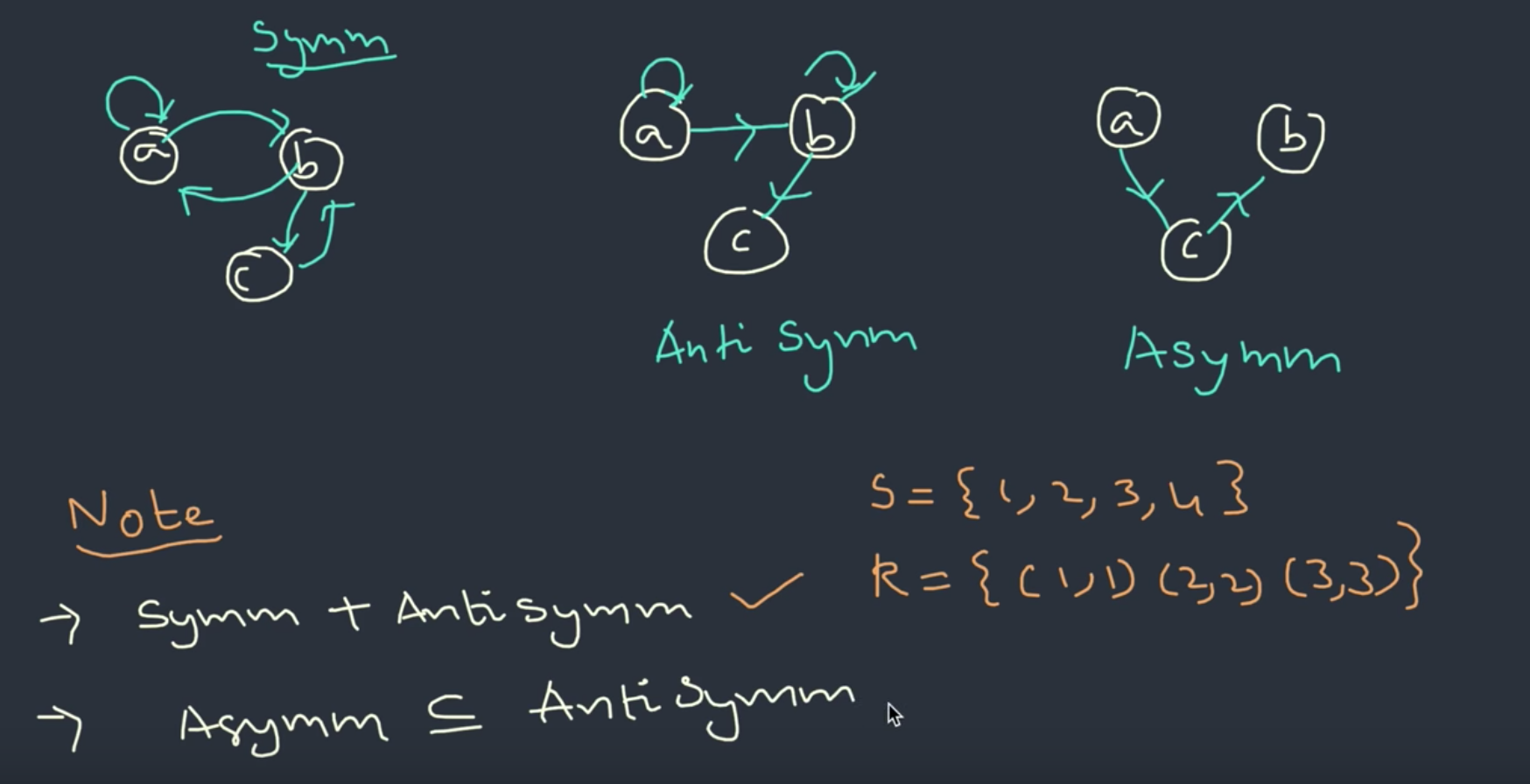Property of Relations
Tags: discrete math
| R | reflexive | irreflexive | symmetric | antisymmetric | asymmetric | transitive |
|---|---|---|---|---|---|---|
| \(\phi\) | ❎ | ✅ | ✅ | ✅ | ✅ | ✅ |
| \(A \times A\) | ✅ | ❎ | ✅ | ❎ | ❎ | ✅ |
| {(1,1),(2,2),(3,3)} | ✅ | ❎ | ✅ | ✅ | ❎ | ✅ |
| {(1,2),(2,1),(1,1)} | ❎ | ❎ | ✅ | ❎ | ❎ | ✅ |
| {(1,2),(2,1),(1,1),(2,2)} | ❎ | ❎ | ✅ | ❎ | ❎ | ✅ |
| {(1,2),(2,3),(1,3)} | ❎ | ✅ | ❎ | ✅ | ✅ | ✅ |
| {(2,3),(1,3),(1,1)} | ❎ | ❎ | ❎ | ✅ | ❎ | ✅ |
| {(3,1),(1,3),(2,3)} | ❎ | ✅ | ❎ | ❎ | ❎ | ❎ |
| {(2,1),(2,3),(1,1)} | ❎ | ❎ | ❎ | ✅ | ❎ | ✅ |
| {(2,3),(3,2),(2,2),(3,3)} | ❎ | ❎ | ✅ | ❎ | ❎ | ✅ |
| {(1,1),(2,2),(2,3),(1,3)} | ❎ | ❎ | ❎ | ✅ | ❎ | ✅ |
| {(1,2),(2,1),(2,3)} | ❎ | ✅ | ❎ | ❎ | ❎ | ❎ |
| {(1,1),(2,1),(1,2),(2,3)} | ❎ | ❎ | ❎ | ❎ | ❎ | ✅ |
| {(1,2),(1,3)} | ❎ | ✅ | ❎ | ✅ | ✅ | ✅ |
| {(2, 3)} | ❎ | ✅ | ❎ | ✅ | ✅ | ✅ |
| {(1,2),(2,1)} | ❎ | ✅ | ✅ | ❎ | ❎ | ❎ |
| identity: $$id_A = {(a,a)\ | \ a \in A}$$ |
reflexive: all diagonal element must be present. \(\forall x \{x \in S \Rightarrow (x,x) \in R\}\)
irreflexive: non diagonal element can present. \(\forall x \{x \in S \Rightarrow (x,x) \not\in R\}\)
symmetric: if \((a, b) \in R\), \((b, a)\) must \(\in R\), \(a\) can \(=b\)
antisymmetric: if \((a, b) \in R\) and \((b, a) \in R\), then \(a\) must \(=b\).
asymmetric: if \((a, b) \in R\), then \((b, a) \not\in R\), even if \(a = b\).
transitive: if \((a, b) \in R\) and \((b, c) \in R\), then \((a, c)\) must \(\in R\)
Using Graph representation

symmetric: if \(a \rightarrow b\), then must have \(b \rightarrow a\), \(a \rightarrow a\) is permitted.
antisymmetric: if \(a \rightarrow b\), then must not have \(b \rightarrow a\), \(a \rightarrow a\) is permitted.
asymmetric: if \(a \rightarrow b\), then must not have \(b \rightarrow a\), \(a \rightarrow a\) is not permitted.
asymmetric \(\subseteq\) antisymmetric
Read more: